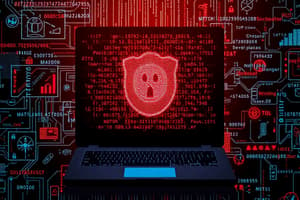Podcast
Questions and Answers
Why are computer incidents so prevalent?
Why are computer incidents so prevalent?
Various reasons such as increasing complexity, expanding systems, BYOD policies, reliance on vulnerable software, and sophisticated attackers.
What can be done to implement a strong security program to prevent cyberattacks?
What can be done to implement a strong security program to prevent cyberattacks?
Develop an overall security strategy, appoint a CISO, conduct employee training, establish security standards for third parties, and perform threat assessments.
What actions must be taken in the event of a successful security intrusion?
What actions must be taken in the event of a successful security intrusion?
Identify the breach, contain the threat, eradicate the cause, recover from the incident, and review and improve security measures.
What is a zero-day exploit?
What is a zero-day exploit?
What are some types of exploits?
What are some types of exploits?
Increasing complexity decreases vulnerability.
Increasing complexity decreases vulnerability.
Which of the following is an example of malware that demands a ransom?
Which of the following is an example of malware that demands a ransom?
What does DDoS stand for?
What does DDoS stand for?
What is meant by 'Document Structure'?
What is meant by 'Document Structure'?
What are 'Main Arguments' within a document?
What are 'Main Arguments' within a document?
What types of data and examples are used in documents?
What types of data and examples are used in documents?
What do we call specific terms essential to a document’s subject matter?
What do we call specific terms essential to a document’s subject matter?
What are 'Central Ideas' in a document?
What are 'Central Ideas' in a document?
What does 'Interconnectedness' refer to within a document?
What does 'Interconnectedness' refer to within a document?
What are the 'Implications' of ideas presented in a document?
What are the 'Implications' of ideas presented in a document?
Who are the 'Authors/Contributors' of a document?
Who are the 'Authors/Contributors' of a document?
What role do 'Influencers' play in a document?
What role do 'Influencers' play in a document?
What does 'Historical Figures' refer to in relation to a document?
What does 'Historical Figures' refer to in relation to a document?
What does 'Time Period' signify in a document's context?
What does 'Time Period' signify in a document's context?
What are 'Cultural Influences' in the context of a document?
What are 'Cultural Influences' in the context of a document?
What are 'Preceding Works' in relation to a document?
What are 'Preceding Works' in relation to a document?
What are the key 'Strengths' of a document?
What are the key 'Strengths' of a document?
What are the 'Weaknesses' of a document?
What are the 'Weaknesses' of a document?
How is the 'Impact and Reception' of a document evaluated?
How is the 'Impact and Reception' of a document evaluated?
What does 'Comparative Analysis' involve?
What does 'Comparative Analysis' involve?
Flashcards are hidden until you start studying
Study Notes
Learning Objectives
- Understand the prevalence of computer incidents and their implications on security.
- Identify strategies to implement robust security programs to thwart cyberattacks.
- Determine necessary actions following a successful security breach.
Zero-Day Exploits
- Occur before the security community is aware of a vulnerability.
- Found in major software platforms like Acrobat Reader, Adobe Flash, iOS, Chrome, and Windows.
- Knowledge of vulnerabilities is sometimes sold on the black market, leading to potential cyberattacks; e.g., an iOS vulnerability reportedly sold for $500,000.
Cybercrime Threat Landscape
- Rising number and severity of cybercrimes impacting individuals, organizations, and governments.
- Organizations counteract cyber threats through various measures:
- Implementing overall security strategies.
- Appointing a chief information security officer (CISO).
- Conducting employee awareness and training programs.
- Establishing security standards for third-party vendors.
- Performing threat assessments.
- Monitoring and analyzing security intelligence.
Increasing Incidents
- Significant surge in computer security incidents between 2014 and 2015 across multiple sectors, including public institutions, media, telecommunications, and utilities.
Reasons for Prevalence of Computer Incidents
- Growing complexity enhances vulnerabilities in systems.
- Constantly evolving systems introduce fresh risks.
- Widespread BYOD policies contribute to security challenges.
- Heavy reliance on commercial software with known vulnerabilities.
- Increasing sophistication of cybercriminals leads to more effective attacks.
Types of Cyber Exploits
- Ransomware: Malware that restricts access to computers/data until demands are met.
- Viruses: Malicious code disguised as legitimate software causing unintended behavior.
- Worms: Harmful programs that replicate themselves in active memory.
- Trojan Horses: Programs with hidden malicious code appearing harmless.
- Blended Threats: Combine features of various malicious programs into one.
- Email Spam: Sending unsolicited emails widely to individuals.
- DDoS Attacks: Overwhelming a target website through compromised computers flooding it with requests.
- Rootkits: Software allowing covert administrative access to a machine.
- Advanced Persistent Threats (APTs): Prolonged attacks where intruders remain undetected to steal data over time.
- Phishing: Trick users to reveal personal information via fraudulent emails; includes spear phishing targeting specific organizations.
- Smishing: Phishing conducted via text messages prompting users to engage with links.
- Vishing: Phishing through voicemail messages instructing victims to call a specific number or visit a website.
Key Concepts
- Document structure includes organization into sections and subsections for clarity.
- Main arguments are core assertions that convey the document's purpose and drive the narrative.
- Evidence and support involve data types, examples, or case studies that substantiate claims made throughout the document.
- Terminology consists of essential terms relevant to the document's subject, aiding in precise communication.
Main Themes
- Central ideas reflect the primary focus points or arguments put forth in the document, shaping its overall message.
- Interconnectedness highlights the relationships between different ideas, illustrating how they support or contrast with one another.
- Implications discuss the consequences or practical applications of the document's ideas in real-world contexts.
Important Figures
- Authors or contributors are key individuals who created the document and may have special backgrounds that influence its content.
- Influencers are significant figures mentioned who may have been referenced or critiqued, impacting the document’s perspective.
- Historical figures are individuals recognized for their contributions that have shaped the subject matter discussed in the document.
Historical Context
- Time period relates to the era during which the document was produced, influencing its relevance to contemporary issues.
- Cultural influences encapsulate societal norms or movements that have impacted the creation and content of the document.
- Preceding works include previous texts that either inform the current document's ideas or present contrasting viewpoints.
Critical Analysis
- Strengths include the document's clarity, depth, and argument validity, contributing to its effectiveness.
- Weaknesses encompass any limitations or biases that may distort conclusions drawn in the document.
- Impact and reception discuss the document's reception among audiences and its influence within the academic or professional field.
- Comparative analysis assesses the document in relation to other similar works, evaluating similarities and differences in themes and approaches.
Studying That Suits You
Use AI to generate personalized quizzes and flashcards to suit your learning preferences.




